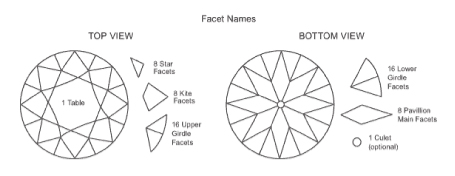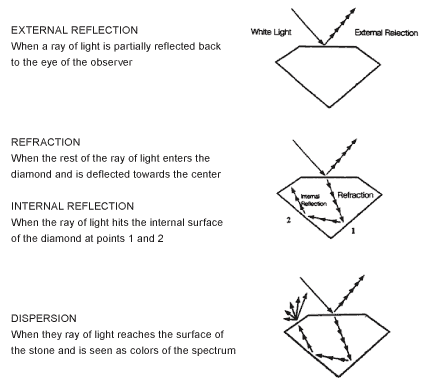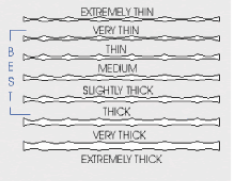All About Diamonds
Diamond Cuts & Shapes
Cut refers to how a diamond is transformed from a piece of dull rough into the beautiful gem that adorns her hand. Cut is the one and only variable that is controlled by man. It is cut that is responsible for the amount of brilliance and fire, resulting in a diamond that sparkles and shows a play of color when light hits it. The earliest diamonds were nothing like their beautiful counterparts of today.
THE CUTTING PROCESS
Cutting diamonds requires much experience, skill, and patience. Cutters apprentice for many years under the watchful eye of a Master. A rough diamond will be passed through many hands on its journey to the final polish.
The first step in the cutting process is marking the rough. The cutter will plan the cutting of the rough and mark it accordingly. He will determine what inclusions can be eliminated, how well the stone will be proportioned and how large the final gem will be.
After marking, the stone will be given to a cutter for splitting either by a process known as cleaving (splitting the stone parallel to the grain) or sawing (splitting the stone by sawing through the crystal against the grain). Sawing is a difficult process that can take several hours and literally be done one millimeter at a time.
The next step in the process is called bruting or rounding. This is when the girdle will be shaped and the cone that will become the pavilion is fashioned. The cutter tries to retain as much of the rough as possible in keeping with the original goals. The result could be that the diamond has something called a girdle natural which is retention of part of the original skin of the rough to eliminate unnecessary loss of weight, and is considered the mark of good craftsmanship.
The next step is performed by the blocker. This is when the culet, the four bezel facets on the crown, and the four pavilion mains are fashioned. The rest of the faceting is accomplished in the step called brillianteering which adds 24 crown facets and 16 pavilion facets.
Lastly the diamond will be ready for its final polish when any external blemishes like girdle fringing is removed and the diamond is finished as the beautiful gem that will out-shine all others.

Because of the diamond’s hardness and refractive index, the finished gem, especially one cut to excellent proportions, will have three very desirable optical properties:
- Brilliance – An intensity of white light reflected both inside and outside (on the surface) of the stone—sparkle
- Scintillation – Flashes of white light that is visible when you move the stone
- Dispersion – Division of a ray of white light into the spectral colors. A reflection of different colors also called “fire”.

PROPORTION, POLISH, AND SYMMETRY ARE THE KEY COMPONENTS OF CUT
While there is not an “Ideal” for fancies like there is for rounds, there is ideal length to width ratios which greatly impacts brilliancy and value.
LENGTH TO WIDTH RATIOS
Length to width approximate ratios: (Divide the length by the width to obtain the ratio)
- Pear Shape – 1.50: 1 to 1.75: 1
- Marquise – 1.75: 1 to 2.25: 1
- Emerald – 1.50: 1 to 1.75: 1
- Oval – 1.33: 1 to 1.66: 1
- Heart – 1.00: 1 to 1.25: 1
PROPORTION (FOR ROUNDS)
The way a diamond is proportioned determines its brilliance and fire; this is especially true of the height of the crown in relation to the depth of the pavilion, and the width of the table facet in relation to the width of the stone. The crown should be 1/3 of the pavilion depth.
- Cutting can take several weeks per stone.
- 50% of the original weight can be lost in cutting.
- Ideal makes can raise prices 15-25% over the average.
- Poor makes can reduce prices 50-60%
- Table and depth will be excellent if crown angles of 34-36 degrees.
- Table and depth will be good if crown angles of 32-34 degrees.
- Table and depth will be fair if crown angles of 30-32 degrees.
- Table and depth will be poor if crown angles of less than 30.

Table
Price per carat should drop for stones where polish is less than good; price should be more on stones that are very good to excellent.
- Ideal – A 53%-57%, plus an excellent depth, will sell for much more
- Excellent – Up to 60%, up to 62% if under 1/2 ct.
- Acceptable – 64%
- Fair – 64%-70%, should sell for less
- Poor – 70%+, should sell for much less

DEPTH
Girdle thickness affects this measurement.
- Ideal – 58-60%
- Excellent – 61-62%
- Acceptable/Good – 62-64%
- Poor – Over 64%
Proper depth should be approximately 60% of narrow width.
POLISH & SYMMETRY
- How the facets align with each other.
- Facets on one side match facets on other side.
- Top facets that align with bottom ones (will affect price the most).
Girdle Thickness – the ideal is “medium” to “slightly thick”.
- Affects value
- Affects durability
Assess girdle thickness at the narrowest sections, where upper and lower girdle facets meet.
Examine the circumference of the entire girdle.
- Extremely/Very thin: a sharp edge under magnification; not visible to the unaided eye.
- Thin: a thin line under magnification; barely visible to the unaided eye.
- Medium: a distinct line under magnification; a thin line to the unaided eye.
- Slightly thick: obvious under magnification; distinct to the unaided eye.
- Thick: very obvious under magnification; obvious to the unaided eye.
- Very thick: distracting under magnification; very obvious to the unaided eye.
- Extremely thick: very distracting under magnification; distracting to the unaided eye.

Extremes in either direction will lower price. In a PS, HS, or MQ, the girdle can be very thick at the point (avoids breakage) and still be an acceptable cut. An extremely thin girdle will sell for less than a thick one because of vulnerability to chipping –– unless the girdle is so thick as to make the diamond appear smaller than it should.
In examining proportion, 3 key areas should be considered:
- Table percentage (ideally, 55-57.5%)
- Crown angle (ideally, 34 1/2% degrees)
- Pavilion angle (ideally, 40 1/2 degrees)

CULET
- Should be small to very small
- A stone with a large, noticeable cutlet will sell for less because it reduces brilliance.
- A chipped or broken cutlet will substantially reduce value.
CUTTING FAULTS
- Sloping table (when table is not perpendicular to the cutlet) ––exhibits a major cutting fault.
- Cutlet – chipped, broken; open or larger; off center.
- Extra facets can reduce brilliance
- Girdle – bearded or fringed (can be repolished) – When the girdle is too thick the diamond will appear smaller. When the girdle is too thin, there is potential for chipping.
- Natural – original skin of the diamond rough; if large and below the girdle, it will be polished off and made into an extra facet. If small and positioned on the girdle, it actually denotes good craftsmanship.
- Bow-tie effect–Marquises, Ovals and Pears – Reflection of the pavilion through the table resulting in a loss of brilliancy.
SHAPE
Since all diamond shapes are very different, unique characteristics determine quality for each shape. Select your shape below to learn how to recognize the most beautiful diamond. If you have additional questions, feel free to contact us so we can help you find the diamond that’s perfect for you.


